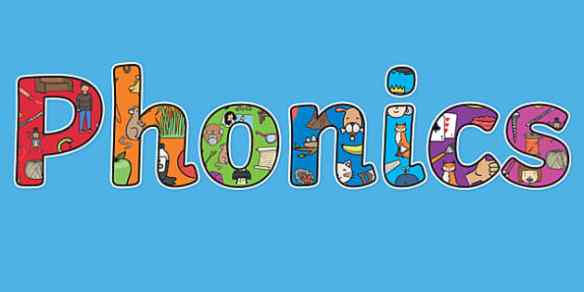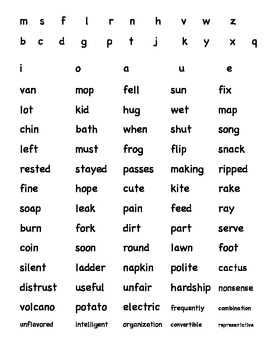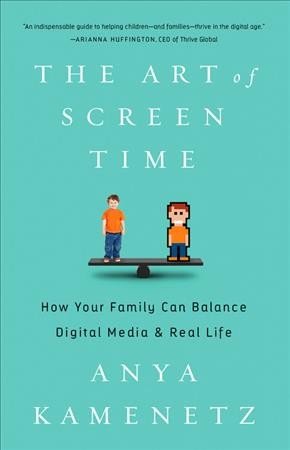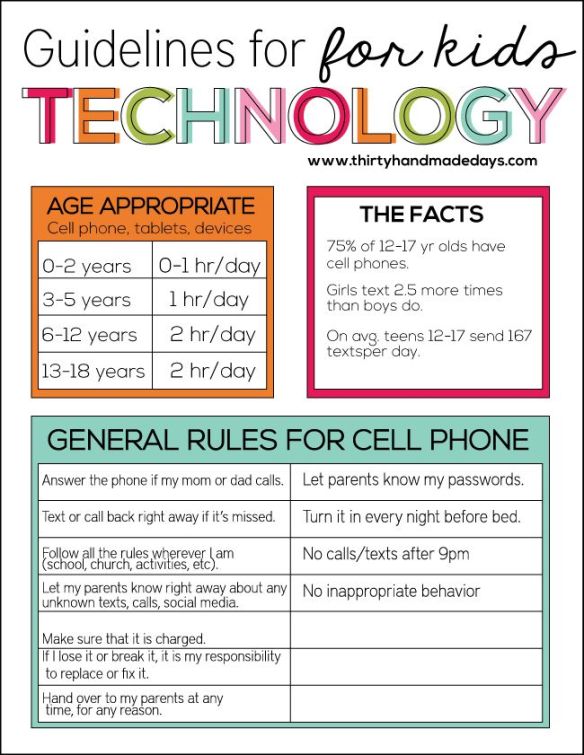Great place to start getting curious about difficult student behavior.



Basic Phonics Skills Test III (BPST III) (For students reading below a 4th-grade decoding level) by John Shefelbine
Basic Phonics Skills Test III
Purpose
The Basic Phonics Skills Test III (BPST) is a phonics assessment that consists of the recognition of letter sounds, specific phonics patterns, and the blending of single syllable and polysyllabic words out of context. The BPST is a tool for teacher to isolate the phonics sounds students can identify and blend successfully.Administration
– Give the student a copy of the BPST Student sheets.
– Begin with the letter sounds portion of the test, or begin with the word lists if
individual letter sounds have already been identified or are not a concern.
– Ask the student to read the sound and/or words aloud from left to right. Words must be blended, not simply sounded out, to be considered correct.
– Record the student’s correct responses with a check mark above the corresponding letter and/or word on the BPST Teacher sheet.
– You may choose to also record the student’s incorrect responses by writing the mispronunciation given above the corresponding letter and/or word.
– Consider stopping when the student is unable to correctly read all or most of the words in two consecutive rows.
– Do not offer the student any assistance except to ask him/her to move on to the next word as needed.Analysis
– Consider carefully the errors the student made in each section to determine
possible areas for instruction and intervention. Any section in which a student
achieved less than 80% proficiency represents a possible area of focus. The order of
sections does not represent a particular instructional sequence.
– It is important to note that a student who mispronounces polysyllabic words out of
context may demonstrate a need for vocabulary instruction versus phonics intervention. Listen to the child read polysyllabic words in the context of an
appropriately leveled text to determine if a vocabulary need is present


BPST-III – – Basic Phonic Skills Test (Word Doc)
Why is this important?
Phonics is the process of mapping the sounds in words to written letters. This is one of the earliest reading skills children should develop, because it introduces them to the link between letters and sounds, known as the alphabetic principle.
A lack of phonics instruction in early childhood can lead to reading difficulties further down the track. It’s important that children can grasp the concept that printed text represents the sounds of spoken words. There are many phonics activities that you can do with your child at home, which will help your child to develop early phonics skills, although it’s important to remember that these activities should always be complemented with regular reading.
We use measures like the BPST 3 to help understand the child’s level of phonics competency to help inform our instruction. Some children who score low will need additional practice with developing their understanding of phonics.

The day after the mass shooting occurred in Florida many kids were talking about the massacre. They were asking a variety of questions like, “Will that happen to us at our school?” or simply “Am I safe at school?” As educators, parents, and community members we have an obligation to know what to say to our kids. This post will review what the National Association of School Psychologist (NASP) recommends.

Talking to Children About Violence: Tips for Parents and Teachers
High profile acts of violence, particularly in schools, can confuse and frighten children who may feel in danger or worry that their friends or loved-ones are at risk. They will look to adults for information and guidance on how to react. Parents and school personnel can help children feel safe by establishing a sense of normalcy and security and talking with them about their fears.
- Reassure children that they are safe. Emphasize that schools are very safe. Validate their feelings. Explain that all feelings are okay when a tragedy occurs. Let children talk about their feelings, help put them into perspective, and assist them in expressing these feelings appropriately.
- Make time to talk. Let their questions be your guide as to how much information to provide. Be patient; children and youth do not always talk about their feelings readily. Watch for clues that they may want to talk, such as hovering around while you do the dishes or yard work. Some children prefer writing, playing music, or doing an art project as an outlet. Young children may need concrete activities (such as drawing, looking at picture books, or imaginative play) to help them identify and express their feelings.
- Keep your explanations developmentally appropriate.Early elementary school children need brief, simple information that should be balanced with reassurances that their school and homes are safe and that adults are there to protect them. Give simple examples of school safety like reminding children about exterior doors being locked, child monitoring efforts on the playground, and emergency drills practiced during the school day.
- Upper elementary and early middle school children will be more vocal in asking questions about whether they truly are safe and what is being done at their school. They may need assistance separating reality from fantasy. Discuss efforts of school and community leaders to provide safe schools.
- Upper middle school and high school students will have strong and varying opinions about the causes of violence in schools and society. They will share concrete suggestions about how to make school safer and how to prevent tragedies in society. Emphasize the role that students have in maintaining safe schools by following school safety guidelines (e.g. not providing building access to strangers, reporting strangers on campus, reporting threats to the school safety made by students or community members, etc.), communicating any personal safety concerns to school administrators, and accessing support for emotional needs.
- Review safety procedures. This should include procedures and safeguards at school and at home. Help children identify at least one adult at school and in the community to whom they go if they feel threatened or at risk.
- Observe children’s emotional state. Some children may not express their concerns verbally. Changes in behavior, appetite, and sleep patterns can also indicate a child’s level of anxiety or discomfort. In most children, these symptoms will ease with reassurance and time. However, some children may be at risk for more intense reactions. Children who have had a past traumatic experience or personal loss, suffer from depression or other mental illness, or with special needs may be at greater risk for severe reactions than others. Seek the help of mental health professional if you are at all concerned.
- Limit television viewing of these events. Limit television viewing and be aware if the television is on in common areas. Developmentally inappropriate information can cause anxiety or confusion, particularly in young children. Adults also need to be mindful of the content of conversations that they have with each other in front of children, even teenagers, and limit their exposure to vengeful, hateful, and angry comments that might be misunderstood.
- Maintain a normal routine. Keeping to a regular schedule can be reassuring and promote physical health. Ensure that children get plenty of sleep, regular meals, and exercise. Encourage them to keep up with their schoolwork and extracurricular activities but don’t push them if they seem overwhelmed.
Suggested Points to Emphasize When Talking to Children
- Schools are safe places. School staff works with parents and public safety providers (local police and fire departments, emergency responders, hospitals, etc.) to keep you safe.
The school building is safe because … (cite specific school procedures).
- We all play a role in the school safety. Be observant and let an adult know if you see or hear something that makes you feel uncomfortable, nervous or frightened.
- There is a difference between reporting, tattling or gossiping. You can provide important information that may prevent harm either directly or anonymously by telling a trusted adult what you know or hear.
- Although there is no absolute guarantee that something bad will never happen, it is important to understand the difference between the possibility of something happening and probability that it will affect you (our school community).
- Senseless violence is hard for everyone to understand. Doing things that you enjoy, sticking to your normal routine, and being with friends and family help make us feel better and keep us from worrying about the event.
- Sometimes people do bad things that hurt others. They may be unable to handle their anger, under the influence of drugs or alcohol, or suffering from mental illness. Adults (parents, teachers, police officers, doctors, faith leaders) work very hard to get those people help and keep them from hurting others. It is important for all of us to know how to get help if we feel really upset or angry and to stay away from drugs and alcohol.
- Stay away from guns and other weapons. Tell an adult if you know someone has a gun. Access to guns is one of the leading risk factors for deadly violence.
- Violence is never a solution to personal problems. Students can be part of the positive solution by participating in anti-violence programs at school, learning conflict mediation skills, and seeking help from an adult if they or a peer is struggling with anger, depression, or other emotions they cannot control.
NASP has additional information for parents and educators on school safety, violence prevention, children’s trauma reactions, and crisis response at www.nasponline.org.
The handout, Talking to Children About Violence: Tips for Parents and Teachers is available in the following languages:
Violence Prevention: A Mental Health Issue Tips for Parents and Educators (NASP)
15 Tips for Talking with Children About School Violence (Colorín Colorado)
School Violence Prevention-Brief Facts and Tips (NASP)

Screen time use amongst kids has increased dramatically in the past couple of years. Families are struggling to curb not only their child’s use but in a lot of cases their own use of screen time. This post will highlight ideas and concepts to help manage the use of screen time so your family can maintain a healthy relationship with technology.
How Screen-Hungry Is Your Child?
Does your child have too much screen time?

How Your Family Can Balance Digital Media and Real Life
Making Family Screen Time Rules
Tips:
• Get clear. Use these questions to gain clarity for yourself, then talk with your family to make your own rules.
• Change as needed. Screen time rules can be re-evaluated as your family perspectives shift and needs evolve.
• Post ’em. Write down your rules and post where everyone can see them to help keep everyone accountable

Screen Time Considerations:
- When does it feel like screen time is most disruptive to our family? What are my kids like when they get too much media?
- How much screen time are my kids getting now? (school work, family together time, free time etc. You may wish to track a week to find out)
- How do I use Screens for work and play? What are my own limits and struggles?
- When would it be convenient for the kids to do media?
- What are my biggest fears or concerns about media usage?
- When is media enriching? When is it replacing an activity I want my kids to be doing instead?
Setting Clear Expectations:
Examples in parentheses are not prescriptions, just ideas to get you thinking – what works for your family?
- What constitutes screen time in your family? Which devices are used, and which are off limits for kids? List each device, how it can be used (i.e. – Tablet: for educational use only – no games. Mom’s phone: totally at her discretion and no games, TV: PS3, Netflix…)
- When are absolute no-screen times of day or events? (before school, at the table, when saying hello/goodbye etc. Use your answer above about ‘when media is most disruptive’ as well as your family values to make choices about this.)
- When are screens allowed?
- When will you make exceptions? (travel, sickness, homework etc…)
- What must be completed before screen time? (chores, homework, outside play etc.)
- Where can devices be used? How will I monitor this activity? (devices in bedrooms? behind a closed door? age dependent? require password access? etc.)
- When do kids have to ask permission from a parent? (downloading games? YouTube? at friend’s houses? when posting online? etc.)
- What are the rules about giving out personal information? (name, address, contact info)
- How should kids interact with guests and screens? (Greetings?Goodbyes?Is media allowed while friends are over?)
- What actions will take away screen time privileges?
- What are the consequences if your trust is breached?
- How should kids treat electronics? What are the consequences if people mistreat electronics?
- SOURCEChart
Fill out the We Can! Screen Time Chart to see how much time your family spends in front of a screen. Keep one chart for each person.
Screen Time Parenting Tips (Common Sense Media)





